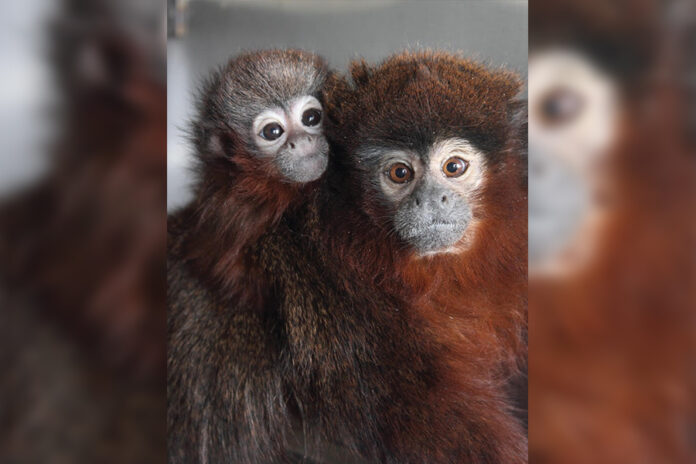Researchers study the effects of oxytocin, alcohol, methamphetamine on pair-bonding in Titi monkeys, prairie voles
With Valentine’s Day having just passed, the topic of love is a frequent conversation starter and comes with lots of questions. What causes people to fall in love? How do close relationships form, and what causes them to end?
The answer may lie in observing monogamous animals, such as Titi monkeys and prairie voles, since they form partner bonds similar to humans.
“People often ask me if humans are monogamous and I avoid the question a little bit, but what I think is the important similarity between these other mammals and humans is that as adults both sexes can form these long term and very affiliative, selective relationships, and a lot of males do help take care of kids,” said Karen Bales, a professor of psychology at UC Davis. “These are commonalities we can study in these species that you can’t study in say a rat.”
Bales studies both Titi monkeys and prairie voles and pointed out that, in terms of relationships, humans are more attached to loved ones than these mammals.
“What is different is that humans have the capability of maintaining very close selective relationships not just with our partner but also with our parents, kids and friends,” Bales said.
“Adults (mammals) are not that attached to their kids. A way to measure attachment is whether one gets upset when someone is gone. The adult Titi monkeys do not get upset if their kids leave.”
Observations of socially monogamous mammals like prairie voles can also tell us more about what neurologically causes pair-bonding in humans.
“Studies in prairie voles have been predictive for human research: neural mechanisms that have been found to regulate pair bond formation in prairie voles have been later found to be involved in social attachments in humans,” said Andrey Ryabinin, a professor in behavioral neuroscience at Oregon Health State University.
Hormones such as oxytocin have also been shown to play a role in pair bonding in both male and female mammals.
“A lot of what I’ve done has been looking at manipulations that are developmental,” Bales said. “We’re researching how being exposed to a bunch of extra oxytocin the day a prairie vole is born effect[s] the ability as an adult to form a pair-bond.”
Bales also studies the effects of oxytocin on non-human primate mammals, such as Titi monkeys.
“We have been doing experiments where we give a little extra nasal oxytocin or temporarily block oxytocin and looking at changes in females,” Bales said. “We studied the males first and now our current funding is to study the neurobiology of pair-bonding in female Titi Monkeys, and I expect there will be differences.”
Ryabinin is also studying the effects of drugs and alcohol in prairie voles in an effort to see the effects of these substances on pair-bonding.
“In these studies, the drugs were not simply administered to the animals by an experimenter without any control by the animal,” Ryabinin said. “Instead, our prairie voles were voluntarily self-administering the drugs. Most of our studies have been with alcohol, but some also examined the effects of methamphetamine. We found that voluntary alcohol consumption had an unexpected sex-dependent effect on pair bonding. Alcohol inhibited pair bonding in males but enhanced it in females. In contrast, methamphetamine inhibited pair bond formation in both male and female prairie voles.”
Ryabinin has concluded that different substances affect pair-bonding through slightly different mechanisms, and his lab is currently studying those mechanisms.
On a different note, research that is based solely on human relationship formation and how we select our partners is also currently being conducted at UC Davis.
“Generally speaking, relationship initiation is a pretty extensive and lengthy process,” said Paul Eastwick, an associate professor of psychology at UC Davis. “It’s a process that can take anywhere from months to years. This is even true in the modern technological age.”
Eastwick also studies ideal partner preferences, which are sets of traits humans say they value and want their partner to have.
“Traits can include things like attractiveness, ambition and trustworthiness,” Eastwick said. “There is general agreement that these traits are positive. But other than that individual differences in who says they care about what particular quality, say you care about attractiveness and I care about ambition, is basically uncorrelated with how much attractiveness and ambition ultimately appeal to your immediate romantic partner. People don’t seem to have a lot of insight into the traits that are uniquely appealing to them.”
Eastwick also explained how certain inherent factors or situations dictate how we select romantic partners.
“If you live in a part of the country that is more religious, for example, you’re more likely to date people that are religious.”
On top of this, people generally tend to date people who are similar to them in terms of levels of attractiveness, a concept known as assortative mating.
Ultimately, relationships among both humans and animals are areas of extensive research and both neurological and social aspects of our lives may affect how we form bonds with partners.
Written by: Jessica Montross — science@theaggie.org




